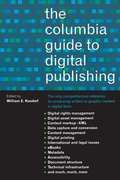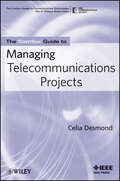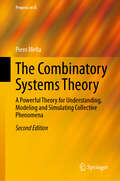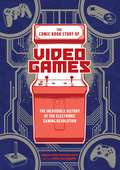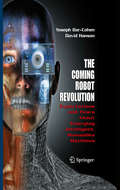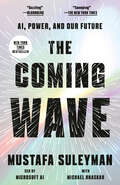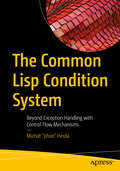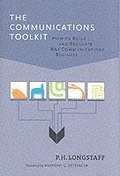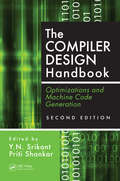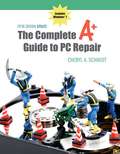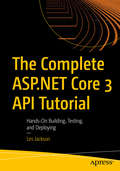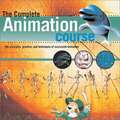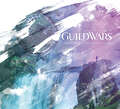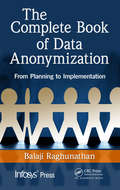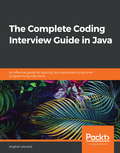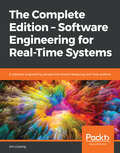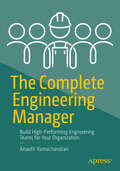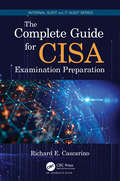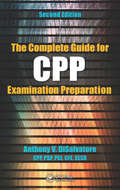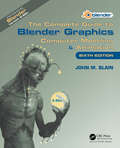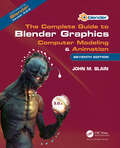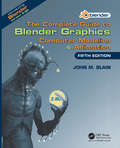- Table View
- List View
The Columbia Guide to Digital Publishing
by William E. KasdorfWhat is metadata? When do you need to archive digital content? How does electronic publication affect copyrights? How can XML and PDF improve your workflow and your publications? There is a digital dimension to virtually all publishing today. Beyond the obvious electronic media -- the music and movies we take for granted, the increasingly indispensable Web, the eBooks that most of us will take for granted in a few years -- almost everything we read, even on paper, was produced digitally. This new digital world offers a steadily increasing number of choices. It is this rich and rapidly changing publishing environment for which The Columbia Guide to Digital Publishingwas created. Although there is a vast amount of information on a host of topics relevant to digital production and publishing available -- some in print, more on the Web -- there has been, until now, no single resource to which those involved in any dimension of publishing could turn for guidance. The Columbia Guide to Digital Publishing fills that need. The Guide is definitive: written by experts in the broad array of subjects it covers, it provides reliable, authoritative, user-friendly information about a vast number of topics. Designed to be the first place to go to learn about any of the numerous interrelated issues that define the digital publishing landscape, it offers readers a multilevel approach, from a brief glossary definition of a technical term or acronym (sometimes all a user needs), to a concise discussion of a topic (comprehensible to the lay person, yet useful for the technical expert). It puts a subject in the context of other topics and broader issues, with real-world examples, liberal cross-references, and pointers to sources of further information in print or electronic form.
The ComSoc Guide to Managing Telecommunications Projects (The ComSoc Guides to Communications Technologies #7)
by Celia DesmondThis pocket guide provides an overview of the telecommunications environment as it has evolved over the past few years, illustrating the need for project management, the significance of project success to the companies, and the application of key project management processes within the telecom environment. Topics covered include: scope management, time management, cost management, procurement management, risk management, communications, quality, human resources, and Integration. It offers professionals a brief and accessible guide to managing telecommunication projects in the 21st century.
The Combinatory Systems Theory: A Powerful Theory for Understanding, Modeling and Simulating Collective Phenomena (Progress in IS)
by Piero MellaThis book adopts the logic of Systems Thinking and Control Systems, presenting a simple but complete theory called the Theory of Combinatory Systems. This new theory describes, interprets, explains, and simulates collective phenomena and their observable effects. Such collective phenomena – many of which are “one way", non-repeatable or reproducible – can all be described and understood using the model, as simple as it is general, of combinatory systems; that is, systems formed by collectivities, or populations of non-connected and unorganized individuals of some species, which appear to be directed by an invisible hand that guides the analogous actions of similar individuals in order to produce an emerging collective phenomenon. This edition includes enhanced theories such as an analysis of potential interactions between combinatory systems and their dynamics, highlighting the role of the environment in which such systems operate. It also includes new examples and enhanced figures that illustrate how combinatory systems are observed in social, biological and physical contexts.
The Combined Power of Research, Education, and Dissemination: Essays Dedicated to Tiziana Margaria on the Occasion of Her 60th Birthday (Lecture Notes in Computer Science #15240)
by Mike Hinchey Bernhard SteffenStarting with a Laurea in Ingegneria Elettronica and a PhD in Computer and Systems Engineering at the Politecnico di Torino, Tiziana has stayed faithful to her love of organized management of composable functionalities in software and systems, with building blocks and MDD, and she strives for coherence and alignment in complex systems through verification, model checking and workflow synthesis. Her quest for simplicity spans technologies (low-code/no-code; ITSy project), business (Business Model Canvas; tools for innovative business models) and disciplines with her concept of the Digital Thread, a metaphor for IT-mediated interoperation of reusable and ideally verified tools and systems in new platforms where reuse, repurposing and evolution are supported by design. Her most recent initiative, R@ISE, aims at opening the world of IT production and adaptation to a wider range of users and professions. Tiziana is a cofounder and managing editor of the International Journal on Software Tools for Technology Transfer, she cofounded the ISoLA conference, and cofounded METAFrame Technologies serving as CEO. She is a Fellow of the Society for Design and Process Science and a Fellow and President of the Irish Computer Society. Throughout her career Tiziana’s successes have been motivated by how best to advance science and engineering through the implementation of techniques in challenging applications, and the contributions in this volume by leading researchers are representative of a community that shares this drive.
The Comic Book Story of Video Games: The Incredible History of the Electronic Gaming Revolution (Comic Book Story of)
by Jonathan HennesseyA complete, illustrated history of video games--highlighting the machines, games, and people who have made gaming a worldwide, billion-dollar industry/artform--told in a graphic novel format. Author Jonathan Hennessey and illustrator Jack McGowan present the first full-color, chronological origin story for this hugely successful, omnipresent artform and business. Hennessey provides readers with everything they need to know about video games--from their early beginnings during World War II to the emergence of arcade games in the 1970s to the rise of Nintendo to today's app-based games like Angry Birds and Pokemon Go. Hennessey and McGowan also analyze the evolution of gaming as an artform and its impact on society. Each chapter features spotlights on major players in the development of games and gaming that contains everything that gamers and non-gamers alike need to understand and appreciate this incredible phenomenon.
The Coming Robot Revolution
by David Hanson Adi Marom Yoseph Bar-CohenThis book discusses the emergence of humanlike robots into our everyday world. It covers the trends, possibilities, and concerns we will all feel with their emergence. Robots will walk, talk, and look ever more like people, and with the speed at which new technologies develop, this may happen very soon. Robots will be in homes, in space, in workplaces, in hospitals--everywhere. Their capabilities will soon surpass what has been usually considered science fiction. In what directions will the technology be taking us, and how will the presence of these robots challenge our identity? This book explores the fascinating implications of robot technology while alerting of its possibly disturbing flipside.
The Coming Wave: AI, Power, and Our Future
by Mustafa SuleymanNEW YORK TIMES BESTSELLER • An urgent warning of the unprecedented risks that AI and other fast-developing technologies pose to global order, and how we might contain them while we have the chance—from a co-founder of the pioneering artificial intelligence company DeepMind and current CEO of Microsoft AI&“A fascinating, well-written, and important book.&”—Yuval Noah Harari &“Essential reading.&”—Daniel Kahneman&“My favorite book on AI.&”—Bill Gates, GatesNotesA Best Book of the Year: CNN, Economist, Bloomberg, Politico Playbook, Financial Times, The Guardian, CEO Magazine, Semafor • Winner of the Inc. Non-Obvious Book Award • Finalist for the Porchlight Business Book Award and the Financial Times and Schroders Business Book of the Year Award We are approaching a critical threshold in the history of our species. Everything is about to change. Soon you will live surrounded by AIs. They will organize your life, operate your business, and run core government services. You will live in a world of DNA printers and quantum computers, engineered pathogens and autonomous weapons, robot assistants and abundant energy. None of us are prepared. As co-founder of the pioneering AI company DeepMind, part of Google, Mustafa Suleyman has been at the center of this revolution. The coming decade, he argues, will be defined by this wave of powerful, fast-proliferating new technologies. In The Coming Wave, Suleyman shows how these forces will create immense prosperity but also threaten the nation-state, the foundation of global order. As our fragile governments sleepwalk into disaster, we face an existential dilemma: unprecedented harms on one side, the threat of overbearing surveillance on the other. How do we ensure the flourishing of humankind? How do we maintain control? How do we navigate the narrow path to a successful future? This groundbreaking book from the ultimate AI insider establishes &“the containment problem&”—the task of maintaining control over powerful technologies—as the essential challenge of our age.
The Commercialisation of Massive Open Online Courses: Reading Ideologies in Between the Lines
by Seb DianatiThis book critically examines the role of Massive Open Online Courses (MOOCs) in higher education, against the backdrop of rapid developments in online learning. Reporting on a method by which one could isolate ideologically charged words from websites, the author underlines the need to pause, question and understand the underlying motives behind MOOCs, and ask fundamental questions about their data use, commercial interests, and ability to provide ‘good’ education. With its step-by-step ideological analysis, the author challenges educators, policymakers, and students alike to reconsider the fabric of online courses and their associated platforms. The book will appeal to scholars of digital education and sociology, as well as scholars from the critical sciences.
The Common Lisp Condition System: Beyond Exception Handling with Control Flow Mechanisms
by Michał "phoe" HerdaDiscover the functioning and example uses of the Common Lisp condition system. This book supplements already existing material for studying Common Lisp as a language by providing detailed information about the Lisp condition system and its control flow mechanisms; it also describes an example ANSI-conformant implementation of the condition system. In part 1 of The Common Lisp Condition System, the author introduces the condition system using a bottom-up approach, constructing it piece by piece. He uses a storytelling approach to convey the foundation of the condition system, dynamically providing code to alter the behavior of an existing program. Later, in part 2, you’ll implement a full and complete ANSI-conformant condition system while examining and testing each piece of code that you write. Throughout, the author demonstrates how to extend Lisp using Lisp itself by using the condition system as an example. This is done while paying proper attention to the CL restart subsystem, giving it attention on a par with the handler subsystem. After reading and using this book, you'll have learned about the inner functioning of the condition system, how to use it in your own Common Lisp coding and applications, and how to implement it from scratch, should such a need arise. What You Will LearnExamine the condition system and see why it is important in Common LispConstruct the condition system from scratch using foundational mechanisms provided by Common LispProgram the condition system and its control flow mechanisms to achieve practical resultsImplement all parts of a condition system: conditions, restarts, handler- and restart-binding macros, signalling mechanisms, assertions, a debugger, and more Who This Book Is For Beginning and intermediate Lisp programmers, as well as intermediate programmers of other programming languages.
The Communications Toolkit: How to Build and Regulate Any Communications Business
by P. H. Longstaff Anthony OettingerThis book provides the tools necessary to build lasting, flexible strategies to survive and grow in these times of transition. Whether you are a business executive, lawmaker, policy analyst, industrialist, stock analyst, lawyer, or judge, these tools will help you to solve real problems right away.
The Compiler Design Handbook: Optimizations and Machine Code Generation, Second Edition
by Priti Shankar Y. N. SrikantToday’s embedded devices and sensor networks are becoming more and more sophisticated, requiring more efficient and highly flexible compilers. Engineers are discovering that many of the compilers in use today are ill-suited to meet the demands of more advanced computer architectures.Updated to include the latest techniques, The Compiler Design Handbook, Second Edition offers a unique opportunity for designers and researchers to update their knowledge, refine their skills, and prepare for emerging innovations. The completely revised handbook includes 14 new chapters addressing topics such as worst case execution time estimation, garbage collection, and energy aware compilation. The editors take special care to consider the growing proliferation of embedded devices, as well as the need for efficient techniques to debug faulty code. New contributors provide additional insight to chapters on register allocation, software pipelining, instruction scheduling, and type systems. Written by top researchers and designers from around the world, The Compiler Design Handbook, Second Edition gives designers the opportunity to incorporate and develop innovative techniques for optimization and code generation.
The Complete A+ Guide To PC Repair Fifth Edition Update (5th Edition)
by Cheryl SchmidtCheryl Schmidt's The Complete A+ Guide to PC Repair, Fifth Edition Update presents the fundamentals of computer desktop and laptop installation, configuration, maintenance, and networking through simple, step-by-step instruction based on CompTIA A+®2011 Edition objectives. With a focused emphasis on security and customer service skills, this comprehensive book on computer repair introduces the most important tools students need to become professional, customer-friendly technicians using today's technology. The A+ Certification Exam criteria are being updated, effective January 2011, to include Windows 7. The Fifth Edition Update now includes Windows 7 material.
The Complete ASP.NET Core 3 API Tutorial: Hands-On Building, Testing, and Deploying
by Les JacksonUse this ASP.NET Core API tutorial and straightforward step-by-step guide to build, test, and deploy an ASP.NET Core API to Azure. It will help you code confidently and efficiently, and provides just what you need for context. The book starts with detailing how to set up your development environment, and then introduces a variety of tools and technologies to build, test, and deploy your API. It covers tools such as .NET Core SDK, (Version 3.1), Visual Studio Code, Git, xUnit, Docker, PostgreSQL, Postman, Azure DevOps, Azure, AutoMapper, and many more.Practical guidance is provided so you can achieve a tangible and valuable outcome, and you also are given a dose of theory on REST (Representational State Transfer), JSON, (JavaScript Object Notation), DTOs (Data Transfer Objects), and the MVC (Model View Controller) architectural pattern.What You Will LearnBuild an ASP.NET Core API using C#, test it, and deploy it to Azure Understand concepts on Entity Framework CoreGain hard-earned secrets, shortcuts, and gotchas throughout the “build along” Get comfortable with ASP NET Core EnvironmentsBe introduced to unit testing, CI/CD pipelines, bearer authentication, and JSON Web Tokens (JWT)Who This Book Is ForDevelopers using the Microsoft stack. Some basic understanding of .NET Core is assumed.
The Complete Animation Course: The Principles, Practice and Techniques of Successful Animation
by Chris PatmoreDesktop computer artists will find a wealth of information in this heavily illustrated book. It instructs in the principles, practice, and techniques of successful animation. The author covers all forms of animation, starting with the basics of making sketches in flip books, and concluding with the latest developments in computer-generated imagery. He demonstrates with practical examples that utilize key areas of modern animation cell art, stop-action with clay or plastic models, and 3D computer-generated and web-based animations. This volume's six chapters cover the following topics: The art of storytelling and storyboarding . . . How to create stop-action animation . . . Simple cell animation, the technique for simple movie cartoon sequences . . . Full cell animation, as used by Disney, Warner Brothers, and similar studios . . . Web animation for showcasing your skill over the Internet . . . and Computer modeling and animation, including 3D modeling. The book's concluding sections discuss modern hardware and software, with emphasis on affordable beginners' equipment. Also provided is an overview of the animation industry and its applications to movies, TV, and computer games. More than 250 instructive illustrations enhance this fascinating how-to volume.
The Complete Art of Guild Wars: ArenaNet 20th Anniversary Edition
by Arenanet Indigo BoockA glorious, full-color tome that includes art and commentary chronicling the ongoing development of the Guild Wars universe.Explore the living history of Tyria through an expansive collection of never-before-seen concept art, production material, and creator commentary from Guild Wars and Guild Wars 2 that offers exclusive insight into an every-changing world inhabited by millions of players! The continuing growth of the Guild Wars franchise is lovingly detailed by the ArenaNet artists themselves in a volume that commemorates the studio's twentieth anniversary. Dark Horse Books and ArenaNet invite all asura, sylvari, norn, char, and humans to add this wonderful art book as a centerpiece to their collections!
The Complete Book of Data Anonymization: From Planning to Implementation (Infosys Press)
by Balaji RaghunathanThe Complete Book of Data Anonymization: From Planning to Implementation supplies a 360-degree view of data privacy protection using data anonymization. It examines data anonymization from both a practitioner's and a program sponsor's perspective. Discussing analysis, planning, setup, and governance, it illustrates the entire process of adapting an
The Complete Coding Interview Guide in Java: An effective guide for aspiring Java developers to ace their programming interviews
by Anghel LeonardExplore a wide variety of popular interview questions and learn various techniques for breaking down tricky bits of code and algorithms into manageable chunks Key Features Discover over 200 coding interview problems and their solutions to help you secure a job as a Java developer Work on overcoming coding challenges faced in a wide array of topics such as time complexity, OOP, and recursion Get to grips with the nuances of writing good code with the help of step-by-step coding solutions Book Description Java is one of the most sought-after programming languages in the job market, but cracking the coding interview in this challenging economy might not be easy. This comprehensive guide will help you to tackle various challenges faced in a coding job interview and avoid common interview mistakes, and will ultimately guide you toward landing your job as a Java developer. This book contains two crucial elements of coding interviews - a brief section that will take you through non-technical interview questions, while the more comprehensive part covers over 200 coding interview problems along with their hands-on solutions. This book will help you to develop skills in data structures and algorithms, which technical interviewers look for in a candidate, by solving various problems based on these topics covering a wide range of concepts such as arrays, strings, maps, linked lists, sorting, and searching. You'll find out how to approach a coding interview problem in a structured way that produces faster results. Toward the final chapters, you'll learn to solve tricky questions about concurrency, functional programming, and system scalability. By the end of this book, you'll have learned how to solve Java coding problems commonly used in interviews, and will have developed the confidence to secure your Java-centric dream job. What you will learn Solve the most popular Java coding problems efficiently Tackle challenging algorithms that will help you develop robust and fast logic Practice answering commonly asked non-technical interview questions that can make the difference between a pass and a fail Get an overall picture of prospective employers' expectations from a Java developer Solve various concurrent programming, functional programming, and unit testing problems Who this book is for This book is for students, programmers, and employees who want to be invited to and pass interviews given by top companies. The book assumes high school mathematics and basic programming knowledge.
The Complete Developer: Master the Full Stack with TypeScript, React, Next.js, MongoDB, and Docker
by Martin KrauseA hands-on, beginner-friendly approach to developing complete web applications from the ground up, using JavaScript and its most popular frameworks, including Node.js and React.js.Whether you&’ve been in the developer kitchen for decades or are just taking the plunge to do it yourself, The Complete Developer will show you how to build and implement every component of a modern stack—from scratch.You&’ll go from a React-driven frontend to a fully fleshed-out backend with Mongoose, MongoDB, and a complete set of REST and GraphQL APIs, and back again through the whole Next.js stack.The book&’s easy-to-follow, step-by-step recipes will teach you how to build a web server with Express.js, create custom API routes, deploy applications via self-contained microservices, and add a reactive, component-based UI. You&’ll leverage command line tools and full-stack frameworks to build an application whose no-effort user management rides on GitHub logins.You&’ll also learn how to: Work with modern JavaScript syntax, TypeScript, and the Next.js frameworkSimplify UI development with the React library Extend your application with REST and GraphQL APIsManage your data with the MongoDB NoSQL databaseUse OAuth to simplify user management, authentication, and authorizationAutomate testing with Jest, test-driven development, stubs, mocks, and fakesWhether you&’re an experienced software engineer or new to DIY web development, The Complete Developer will teach you to succeed with the modern full stack. After all, control matters. Covers: Docker, Express.js, JavaScript, Jest, MongoDB, Mongoose, Next.js, Node.js, OAuth, React, REST and GraphQL APIs, and TypeScript
The Complete Edition – Software Engineering for Real-Time Systems: A software engineering perspective toward designing real-time systems
by Jim CoolingAdopt a diagrammatic approach to creating robust real-time embedded systems Key Features Explore the impact of real-time systems on software design Understand the role of diagramming in the software development process Learn why software performance is a key element in real-time systems Book Description From air traffic control systems to network multimedia systems, real-time systems are everywhere. The correctness of the real-time system depends on the physical instant and the logical results of the computations. This book provides an elaborate introduction to software engineering for real-time systems, including a range of activities and methods required to produce a great real-time system. The book kicks off by describing real-time systems, their applications, and their impact on software design. You will learn the concepts of software and program design, as well as the different types of programming, software errors, and software life cycles, and how a multitasking structure benefits a system design. Moving ahead, you will learn why diagrams and diagramming plays a critical role in the software development process. You will practice documenting code-related work using Unified Modeling Language (UML), and analyze and test source code in both host and target systems to understand why performance is a key design-driver in applications. Next, you will develop a design strategy to overcome critical and fault-tolerant systems, and learn the importance of documentation in system design. By the end of this book, you will have sound knowledge and skills for developing real-time embedded systems. What you will learn Differentiate between correct, reliable, and safe software Discover modern design methodologies for designing a real-time system Use interrupts to implement concurrency in the system Test, integrate, and debug the code Demonstrate test issues for OOP constructs Overcome software faults with hardware-based techniques Who this book is for If you are interested in developing a real-time embedded system, this is the ideal book for you. With a basic understanding of programming, microprocessor systems, and elementary digital logic, you will achieve the maximum with this book. Knowledge of assembly language would be an added advantage.
The Complete Engineering Manager: Build High-Performing Engineering Teams for Your Organization
by Ananth RamachandranTake a 360-degree tour of the engineering manager’s role and responsibilities. This book brings them to life with practical scenarios and references and ensures their relevance to your daily work. From upkeeping technical skills, to managing people and stakeholders, to ensuring timely deliverables, the job of the engineering manager is fast-paced, complex, and often short on learning resources. Fear not, this book has you covered with tips on managing evolving processes, delivering impactful projects in a timely manner, setting goals and priorities among product and technical initiatives, and helping your team focus and deliver. Business priorities are changing at a much faster pace than ever before with new technologies being introduced and adopted regularly. This book will help managers adopt modern practices to meet this moment and aid them in helping engineering teams succeed. The Complete Engineering Manager will leave you with a broader perspective and deeper skill set to apply to engineering management. What You Will Learn Employ the SELF framework for self-management and learn to build trust with team members Manage performance and craft individualized growth plans for employee success Evolve your team’s development, delivery, and technical processes to improve their efficiency Drive impact for your organization through prioritization, strategy and value delivery Build a high-performing engineering team with a strong and positive culture Who This Book is For New, aspiring, and experienced engineering managers who are looking for resources to address challenges in their role.
The Complete Guide for CISA Examination Preparation (Internal Audit and IT Audit)
by Richard E. CascarinoThe Complete Guide for CISA Examination Preparation delivers complete coverage of every topic on the latest release of the Certified Information Systems Auditor (CISA) exam. The author is an IT security and auditing expert and the book covers all five exam domains. This effective self-study system features chapter learning objectives, in-depth explanations of each topic, and accurate practice questions. Each chapter includes exam tips that highlight key exam information, hands-on exercises, a summary that serves as a quick review, and end-of-chapter questions that simulate those on the actual exam. Designed to help candidates pass the CISA exam easily, it also serves as an ideal on-the-job reference. Richard E. Cascarino, MBA, CIA, CISM, CFE, CRMA, is well known in international auditing. Richard is a principal of Richard Cascarino & Associates. He has over 31 years’ experience in audit training and consulting. He is a regular speaker at national and international conferences and has presented courses throughout Africa, Europe, the Middle East and the USA. Richard is a Past President of the Institute of Internal Auditors in South Africa, was the founding Regional Director of the Southern African Region of the IIA-Inc. and is a member of ISACA, and the Association of Certified Fraud Examiners, where he is a member of the Board of Regents for Higher Education. Richard was Chairman of the Audit Committee of Gauteng cluster 2 (Premier's office, Shared Services and Health) in Johannesburg and is currently the Chairman of the Audit and Risk Committee of the Department of Public Enterprises in South Africa. Richard is also a visiting Lecturer at the University of the Witwatersrand, author of the book Internal Auditing: An Integrated Approach, now in its third edition. This book is extensively used as a university textbook worldwide. In addition, he is the author of the Auditor's Guide to IT Auditing, Second Edition and the book Corporate Fraud and Internal Control: A Framework for Prevention. He is also a contributor to all four editions of QFINANCE, the Ultimate Resource.
The Complete Guide for CPP Examination Preparation
by Anthony V. DiSalvatore (CPP PSP & PCI)Originally written by a team of Certified Protection Professionals (CPPs), Anthony DiSalvatore gives valuable updates to The Complete Guide for CPP Examination Preparation. This new edition contains an overview of the fundamental concepts and practices of security management while offering important insights into the CPP exam.Until recently the sec
The Complete Guide to Blender Graphics: Computer Modeling & Animation
by John M. BlainBlenderTM is a free Open Source 3D Computer Modeling and Animation Suite incorporating Character Rigging, Particles, Real World Physics Simulation, Sculpting, Video Editing with Motion Tracking and 2D Animation within the 3D Environment. Blender is FREE to download and use by anyone for anything. The Complete Guide to Blender Graphics: Computer Modeling and Animation, Sixth Edition is a unified manual describing the operation of the program with reference to the Graphical User Interface for Blender Version 2.82a. A reader of the Sixth Edition should use Blender 2.82a when learning the program and treat it as a training exercise before using any later versions Key Features: The book provides instruction for New Users starting at the very beginning. Instruction is presented in a series of chapters incorporating visual reference to the program's interface. The initial chapters are designed to instruct the user in the operation of the program while introducing and demonstrating interesting features of the program. Chapters are developed in a building block fashion providing forward and reverse reference to relevant material.
The Complete Guide to Blender Graphics: Computer Modeling & Animation
by John M. BlainBlenderTM is a free Open Source 3D Computer Modeling and Animation Suite incorporating Character Rigging, Particles, Real World Physics Simulation, Sculpting, Video Editing with Motion Tracking and 2D Animation within the 3D Environment. Blender is FREE to download and use by anyone for anything. The Complete Guide to Blender Graphics: Computer Modeling and Animation, Seventh Edition is a unified manual describing the operation of the program with reference to the Graphical User Interface for Blender Version 3.0.0, including nearly 100 pages of completely new content. The book introduces the program’s Graphical User Interface and shows how to implement tools for modeling and animating characters and created scenes with the application of color, texture and special lighting effects. Key Features: The book provides instruction for New Users starting at the very beginning. Instruction is presented in a series of chapters incorporating visual reference to the program's interface. The initial chapters are designed to instruct the user in the operation of the program while introducing and demonstrating interesting features of the program. Chapters are developed in a building block fashion providing forward and reverse reference to relevant material. The book is also available in a discounted set along with Blender 2D Animation: The Complete Guide to the Grease Pencil.
The Complete Guide to Blender Graphics: Computer Modeling & Animation, Fifth Edition
by John M. BlainBlender™ is a free Open Source 3D Creation Suite supporting the entire modeling and animation pipeline – modeling, rigging, animation, simulation, rendering, compositing and motion tracking. The program also includes Video Editing and Grease Pencil 2D Animation. <P><P>The program is free to download and use by anyone for anything. <P><P>The Complete Guide to Blender Graphics: Modeling and Animation, 5th Edition is a unified manual describing the operation of Blender version 2.80 with its New Improved Interface, New Workspaces and New Eevee Render System. <P><P>This book introduces the program's Graphical User Interface and shows how to implement tools for modeling and animating characters and creating scenes with the application of color, texture and special lighting effects. <P><P>Key Features: <li>The book is designed to lead new users into the world of computer graphics using Blender 2.80 and to be a reference for established Blender artists. <li>The book presents instruction in a series of short chapters with visual references and practical examples. <li>Instructions are structured in a building-block fashion using contents in earlier chapters to explain more complex operations in later chapters.
